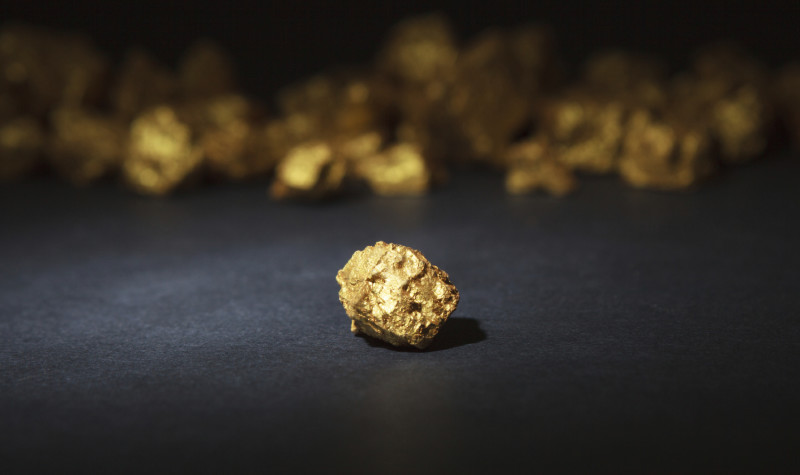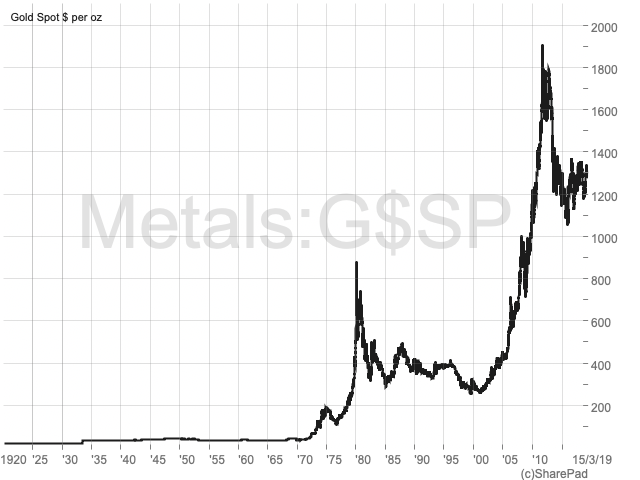The ecstasy of gold

Mark Watson Mitchell explains some very interesting facts about gold – and why the precious yellow metal is a long-term winner!
When Napoleon escaped from Elba in 1815 and managed to get straight back into France, he started to go about raising an army. The price of gold was then the equivalent of £4.32 an ounce; however, overnight it leapt to £5.35 on the back of significant demand. The London bullion house Mocatta & Goldsmid declared that the big buyer was Nathan Mayer Rothschild, acting on behalf of the British Treasury. His orders were to dispatch the gold quickly to the Duke of Wellington. Not until Napoleon was defeated, at the Battle of Waterloo, did the gold price simmer down.
| First seen in Master Investor Magazine
Never miss an issue of Master Investor Magazine – sign-up now for free! |
In November 1979, the US froze Iran’s assets, which was just a few weeks before the Soviet Union invaded Afghanistan. In the two months to late January 1980, the price of gold shot up from $400 an ounce to $850. After Iran’s assets were unfrozen, and it became evident that the Soviet Union was hopelessly tied up with Afghanistan, the price fell back to the $400 level.
Gold has proved itself as the enduring talisman for troubled times, such as in times of war, economic uncertainty and geopolitical instability.As Disraeli said, “more men have been knocked off balance by gold than by love”. For well over 6,000 years, men and women have fought for it, died for it, cheated for it and slaved for it.
The first gold rush of 1697 brought gold from Brazil into London, partly transported by Moses Mocatta on ships owned by the East India Company, which had a Royal Charter from Queen Elizabeth I.
This inflow of gold led to demand for a purpose-built London vault, which the Bank of England duly set up. Their ‘bullion warehouse’ served the whole of the European market, as it does now, and was further stocked by the influx to London from the subsequent gold rushes in California, Australia and South Africa.
The refineries that were set up to process this gold were located close to the Bank of England, which played a key role in being a custodian, regulator and facilitator of lending and selling of gold by other banks. In 1750, the Bank set up the London Good Delivery List, which formally recognised those refineries that produced gold bars of a certain standard and could therefore be allowed to enter the London market. Today, this list is regarded as the only globally accepted accreditation for the bullion market, ensuring that the wholesale bullion bars traded in the market meet standards and quality required by Good Delivery.
By 1850, the London gold market was dominated by five companies (N M Rothschild & Sons, Mocatta & Goldsmid, Pixley & Abell, Samuel Montagu & Co. and Sharps Wilkins), which 150 years later would form the London Gold Market Fixing Company. In 1919, it established the first Gold Price fix, which is the setting of the price of gold by market makers who meet twice a day, at 10:30 and 15:00 GMT. Being at the centre of international time zones facilitated London as being the ideal place from which to operate such a market.

A global market – with London at its centre
The trade in bullion is London-based with a global reach of activity and participants. Today, the Bank of England has one of the world’s largest gold vaults and is the second-largest custodian of gold in the world, after the New York Federal Reserve.
The Old Lady’s vaults hold over 400,000 bars of gold, worth over £100bn. It also provides safe custody for the United Kingdom’s gold reserves, and for other central banks. This supports financial stability by providing central banks with access to the liquidity of the London gold market.
Some 65% of the world’s gold production comes from surface mines, with the balance from underground gold mines. Mine production accounts for the largest part of gold supply – typically some 75% each year – with the remaining coming from recycling. The majority of recycled gold, some 90%, comes from jewellery, with gold extracted from technology providing the residual 10%. Around 50% of the gold mined today is used in jewellery.
It is estimated that around 187,200 tonnes of gold, which could fit into a crate of 21 metres cubed, has been mined since the beginning of civilisation. Only 10% of the world’s gold was mined before the California Gold Rush, which saw some 40,000 miners join the stampede for the yellow metal, of which only a very small few ever got rich.
It is rarer to find a one-ounce nugget of gold than a five-carat diamond. The largest ever true gold nugget, the ‘Welcome Stranger’, weighed 2,316 troy ounces when found at Moliagul in Australia in 1869. A ‘London Good Delivery Bar’ is 400 troy ounces. An ounce of pure gold can be hammered into a single sheet 9 metres square or it can be pulled into a wire 50 miles long. All of the existing gold can be pulled into a 5-micron thick wire which could wrap around the world 11.2 million times.
Carats and ounces
| First seen in Master Investor Magazine
Never miss an issue of Master Investor Magazine – sign-up now for free! |
The purity of gold is measured by its fineness (parts per 1,000) or by the carat scale. Pure gold (1,000 parts) is 24 carat; London Good Delivery is 995 parts. Most coins are 916 parts or 22 carats, while high quality jewellery is 750 parts or 18 carats. In the UK, 9 carat (375 parts) is the minimum accepted for the metal to be legally classed as gold. Other metals are combined with gold, like silver and copper, in varying ratios which lower the carat.
By the way, the term carat is derived from Greek and Arabic words, meaning ‘the fruit of the carob tree’. The seeds from the tree were known for their consistency and used to balance the scales used by merchants at ancient bazaars.
The weight of gold is customarily measured in troy ounces, which is the equivalent of 31.10 grams. A kilo bar is 32.15 oz. troy, and 1 metric tonne is 32,150 oz. troy.
Today, the top ten largest producers of gold, in terms of approximate tonnage, are: China (429 tonnes), Australia (289 tonnes), Russia (272 tonnes), United States (244 tonnes), Canada (171 tonnes), Peru (167 tonnes), South Africa (157 tonnes), Finland (130 tonnes), Mexico (122 tonnes), Guyana (114 tonnes) and Brazil (92 tonnes).
Gold plays an important part in central banks’ reserves management. The largest holders of gold reserves are the United States (8,133 metric tonnes), Germany (3,370), the IMF (2,814), Italy (2,452), France (2,436), Russia (2,066), China (1,843), Switzerland (1,040), Japan (765), Netherlands (612) and India (592). The UK holds 310 metric tonnes – which is a mere 7.3% of our foreign exchange reserves – while the US holds 74%, Germany 69%, Italy 65% and France 59%.
A safe haven in uncertain times
Gold offers a long-term safe-haven for those looking to protect and preserve the value of their wealth, because it is expected to hold significant value. There are hundreds of gold mining prospecting and producing companies quoted in various markets. Compared to the value of gold itself, they can be considered as riskier investments.
There are three main types of gold bullion: bars, rounds, and coins. Each type comes in a variety of sizes. Bars may range from a single gram to 100 ounces each. Rounds and coins are commonly sold in 1 ounce and fractional sizes.
The main difference between a round and a coin is that the former is produced by a private mint while the latter is produced by a government mint. A government-minted gold coin typically has a legal tender face value attached to it – which is considerably less than its intrinsic metal value.
Specialty products such as jewellery and collectors’ items are generally not considered to be bullion. Bullion investors should avoid collectible (numismatic) coins that carry high premiums over spot prices.
Very important information
When buying bullion coins or collectable coins, ask for the ‘melt value’, which is the basic intrinsic bullion value of a coin if it was melted and sold.
Always get an independent appraisal of the specific gold product that you are considering.
Consider additional costs, such as insurance and safe deposit boxes, which will cut into the investment potential.
When buying gold that is stored in a third-party security facility, take extra precautions to ensure that the metal exists, is of the quality described and is properly insured.
Advice from The US Federal Trade Commission
Where next for gold?
| First seen in Master Investor Magazine
Never miss an issue of Master Investor Magazine – sign-up now for free! |
Understandably, the gold price tends to rise as investors in other markets get the jitters. Although it is generally assumed that the cash cost of mining one ounce is around $700, many observers reckon that it is now closer to the $1,000 level. The price of 1 troy ounce peaked at $1,891 in 2011, but came back down to $1,099 and is currently around $1,300. The big question, however, is where is it going now?
Here, in the UK, a big concern is Brexit. There are many factors causing investors to be cautious. Will we or won’t we leave, how hard an exit will it be, will it trigger another general election. A problem is that the UK is not the only country going down the road of leaving the eurozone. Italy’s political upheaval could see them follow us. Losing two major nations would be a huge blow to the EU economy and the stability of its financial institutions. And Spain may not be that far behind either.
It is now evident that central banks have been buying-up gold at a rate not seen since World War II, driven by concerns over geopolitics, government debt, inflation and the strong dollar.
And although the yellow metal has at times caused short-term pain, it can give better returns than other asset classes in the long-term.
(Sources: the Bank of England; the World Gold Council; Gold.co.uk; Bullion By Post; Forbes; Money Metals Exchange; Gold Price; Quartz; OANDA; Timothy Green; and the US Federal Trade Commission).

from above: 187,200 tonnes of gold, which could fit into a crate of 21 metres cubed
err, no. It would fit in a create 21m by 21m by 21m or, to put it in cubic meters, 9800 meters cubed.
lying shill ! you know damned well the physical has found a monetary plateau that facilitates book cooking , balance sgeet manipulation , and laundering to the crypto side . cash out folks , they are going to squeeze you till you puke .